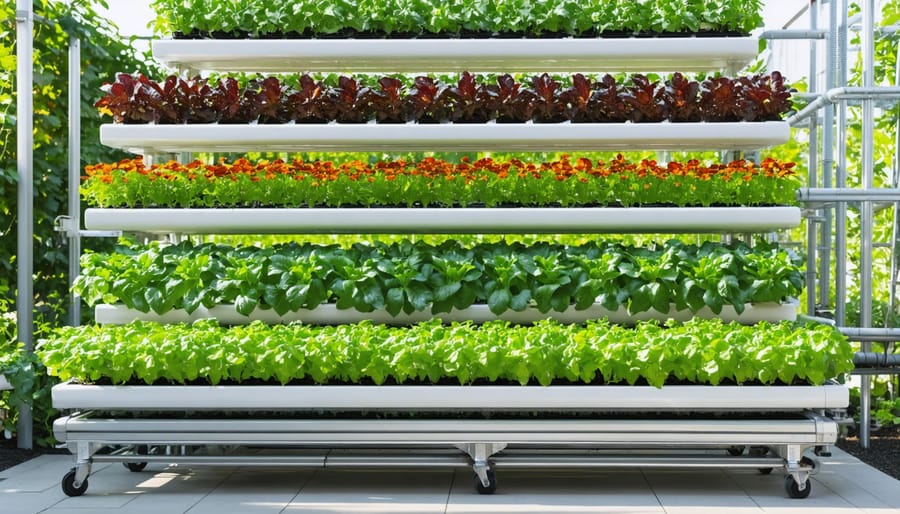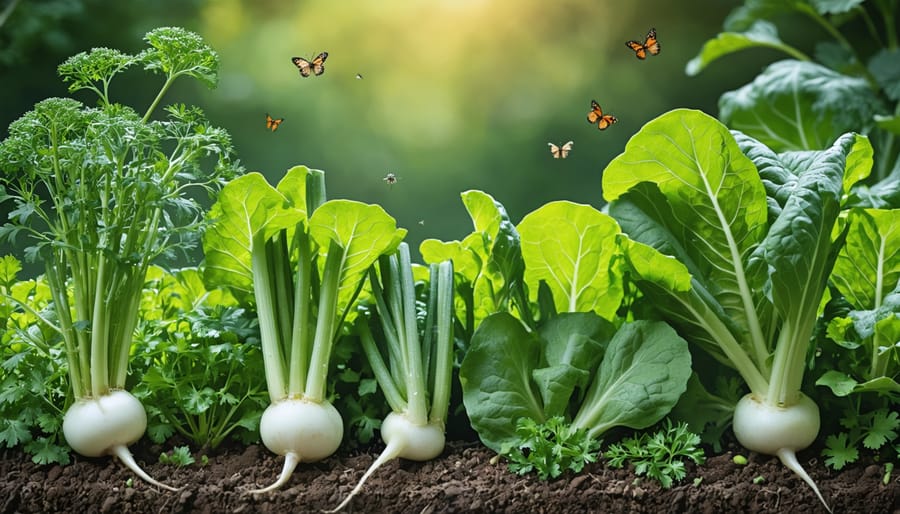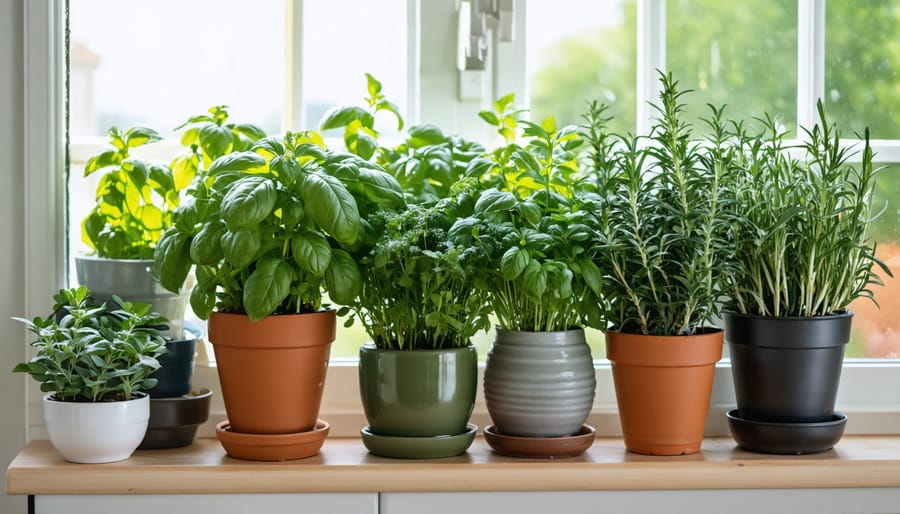Transform your backyard into a soil-free oasis by mastering hydroponic gardening basics in the great outdoors. Outdoor hydroponics combines the precision of controlled nutrients with nature’s free sunshine, offering up to 30% faster growth rates and 90% less water consumption than traditional gardening. Position your system in a sheltered area that receives 6-8 hours of direct sunlight, protecting it from harsh winds while maintaining optimal growing conditions. Install automated monitoring systems to adjust nutrient levels and pH balance as outdoor temperatures fluctuate throughout the day. Connect multiple growing stations using food-grade PVC piping to create a scalable system that maximizes limited space while producing fresh vegetables year-round.
Whether you’re a tech-savvy gardener or simply looking to grow more with less space, outdoor hydroponics offers a sustainable solution that bridges traditional gardening with modern innovation. The ability to control growing conditions while harnessing natural elements makes this method particularly attractive for urban gardeners and sustainability enthusiasts alike.
Why Take Your Hydroponics Outside?
Natural Light Benefits
One of the biggest advantages of outdoor hydroponic gardening is harnessing the power of natural sunlight. While indoor systems rely heavily on artificial lighting, which can significantly impact the cost-effectiveness of hydroponics, outdoor systems benefit from free, abundant solar energy. Natural sunlight provides the full spectrum of light that plants need for optimal growth, resulting in stronger stems, more vibrant foliage, and often better-tasting produce.
Plants grown under natural sunlight typically develop more robust defensive mechanisms against pests and diseases, thanks to exposure to UV rays. You’ll also notice more compact plant growth and deeper colors in leafy greens when compared to artificial lighting. The intensity and duration of sunlight changes naturally with the seasons, which can help create more natural growing cycles for your plants.
Best of all, using natural sunlight can reduce your electricity costs significantly – sometimes by as much as 30-40% compared to indoor systems. This makes outdoor hydroponics an environmentally friendly and economically smart choice for many gardeners.
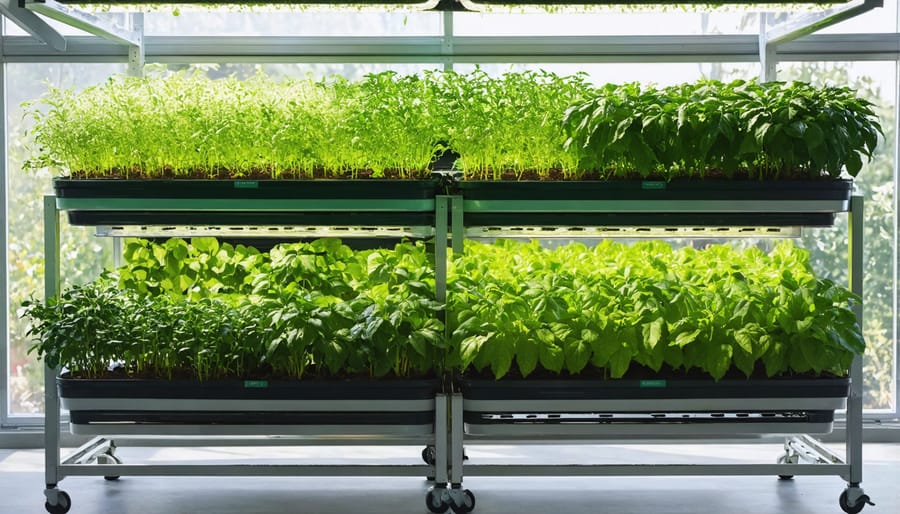
Space Optimization
One of the most compelling advantages of outdoor hydroponics is its ability to maximize limited yard space. Unlike traditional soil gardens that require extensive ground area, vertical hydroponic systems allow you to grow upward instead of outward, making the most of every square foot.
Even a modest patio or deck can become a productive growing space with stackable hydroponic towers or wall-mounted systems. These space-efficient solutions let you grow multiple plants in the footprint typically needed for just one traditional garden plant. For example, a 4-square-foot hydroponic tower can support up to 20 lettuce plants, while the same space in a soil garden might only accommodate 4-6 plants.
Consider utilizing fence lines, walls, and railings for mounting growing channels or hanging systems. Unused corners of your yard can be transformed into productive growing zones with compact NFT (Nutrient Film Technique) systems. By thinking vertically and utilizing often-overlooked spaces, you can create an abundant garden without sacrificing valuable outdoor living areas.
Setting Up Your Outdoor Hydroponic Garden
Choosing the Right Location
Selecting the perfect spot for your outdoor hydroponic system is crucial for success. Start by finding a location that receives 6-8 hours of sunlight daily, though you’ll want to provide some protection during intense afternoon heat. Consider installing shade cloth or positioning your system where it gets natural shade during the hottest part of the day.
Wind exposure is another vital factor. While some airflow is beneficial for plant health, strong winds can damage your system and increase water evaporation. Look for areas sheltered by fences, walls, or natural windbreaks. If needed, you can create temporary wind barriers using garden screens or trellises.
Access to electricity and water is essential. Your system needs to be close enough to power outlets for pumps and timers, and within reach of a reliable water source. Remember to account for the weight of your fully loaded system – a level, stable surface is non-negotiable. Concrete patios, reinforced decking, or well-compacted ground are all suitable options.
Temperature stability is also important. Avoid placing your system against heat-reflecting surfaces like light-colored walls or metal fencing, as these can create hot spots. Consider seasonal changes too – what works in spring might need adjustment for summer or fall growing conditions.
Finally, ensure your chosen location is easily accessible for daily maintenance and monitoring. You’ll want to check water levels, adjust nutrient solutions, and harvest your crops without any awkward reaching or stretching.
Weather Protection Strategies
Weather can pose significant challenges for outdoor hydroponic gardens, but with proper protection strategies, your system can thrive year-round. Start by installing a sturdy shade cloth during intense summer months to prevent leaf burn and excessive water evaporation. For areas with frequent rain, consider building a clear polycarbonate roof that allows sunlight while keeping your nutrient solution from becoming diluted.
Wind protection is crucial for outdoor systems. Install windbreaks using materials like garden netting or clear plastic sheeting, ensuring they’re securely anchored but still allow for adequate airflow. During colder months, wrap your growing containers with insulating materials such as bubble wrap or horticultural fleece to maintain consistent root temperatures.
Temperature fluctuations can be managed using simple solutions like painting reservoirs white to reflect heat, or using underground reservoir systems to maintain more stable temperatures. For extreme weather conditions, consider investing in a greenhouse or hoop house that can be partially opened during mild weather and sealed during harsh conditions.
Automated monitoring systems can be invaluable for weather protection. Install temperature sensors and automatic covers that can protect your plants when you’re not around. Remember to regularly check weather forecasts and prepare your system accordingly – a little preparation goes a long way in protecting your hydroponic investment from Mother Nature’s surprises.
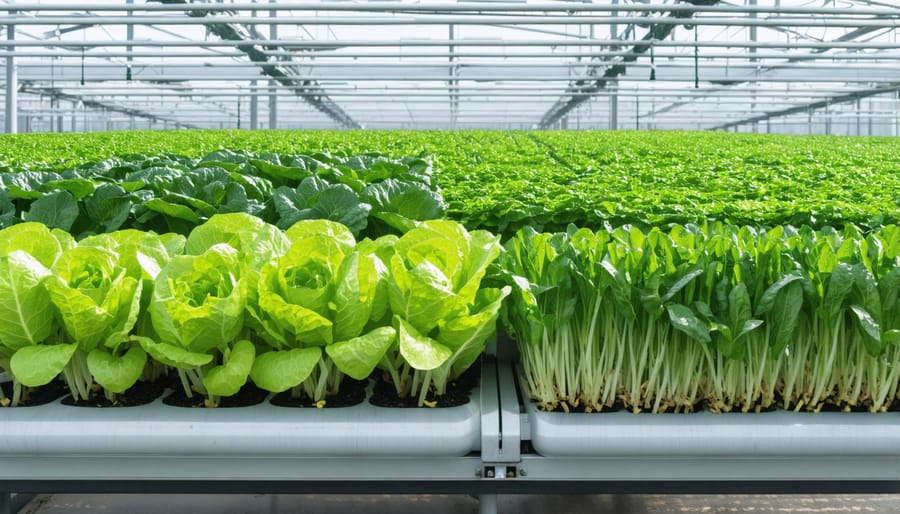
Essential Equipment
To get started with outdoor hydroponic gardening, you’ll need several essential pieces of equipment. First, you’ll need a sturdy growing system – either a ready-made unit or DIY setup using food-grade containers. These should be UV-resistant to withstand sun exposure and weather conditions.
A reliable pump system is crucial for circulating your nutrient solution. Choose a submersible pump rated for outdoor use, and consider having a backup on hand. You’ll also need growing media to support your plants – popular options include expanded clay pellets, rockwool, or coconut coir.
Your nutrient reservoir should be insulated and light-proof to maintain stable temperatures and prevent algae growth. A quality nutrient solution specifically formulated for hydroponics is essential, along with a pH testing kit and adjusters to maintain optimal levels between 5.5 and 6.5.
Don’t forget about environmental monitoring tools. A digital thermometer for both air and solution temperatures, plus an EC (electrical conductivity) meter to measure nutrient concentration, will help you maintain ideal growing conditions.
For larger setups, consider installing a timer system to automate nutrient circulation and any supplemental lighting you might need during shorter winter days. Basic maintenance supplies like cleaning brushes, net pots, and spare tubing will also come in handy.
Finally, invest in a backup power system or battery-operated air pump to protect your plants during power outages, especially important for outdoor systems that rely on consistent circulation.
Maintaining Your Outdoor System
Seasonal Adjustments
Successfully maintaining an outdoor hydroponic garden requires adapting your system to different seasons and weather conditions. During summer months, protect your plants from intense heat by using shade cloth or positioning them where they receive morning sun but afternoon shade. Adding a cooling system, such as misters or fans, can help maintain optimal temperatures for your plants.
As temperatures drop in fall, consider installing clear plastic panels around your system to create a greenhouse effect while still allowing sunlight to reach your plants. These panels also protect against strong winds that could damage delicate stems or disturb nutrient solutions.
Winter presents unique challenges for outdoor hydroponics. If you live in a mild climate, insulating your reservoir and pipes with foam wrapping can prevent temperature fluctuations. For regions with freezing temperatures, you’ll need to either move your system to a protected area or invest in heating elements to maintain water temperature between 65-75°F (18-24°C).
Spring brings its own set of adjustments. Be prepared for rain by ensuring proper drainage and covering your nutrient reservoir to prevent dilution. This is also the time to check and clean all system components after winter storage.
Year-round maintenance tips include:
– Monitoring nutrient solution temperature daily
– Adjusting pH levels more frequently during extreme weather
– Using light-colored containers to reflect heat in summer
– Installing automatic timers for consistent feeding schedules
– Adding windbreaks during stormy seasons
– Checking water levels more often during hot weather
Remember that different plants have varying temperature tolerances, so choose crops that match your seasonal conditions for the best results.
Common Challenges and Solutions
While outdoor hydroponic gardening can be rewarding, it comes with its own set of challenges. One of the most common issues is temperature fluctuation, which can affect nutrient absorption and plant growth. To combat this, consider using shade cloth during peak summer hours and insulating your system’s reservoir to maintain stable temperatures.
Algae growth is another frequent concern, especially when systems are exposed to direct sunlight. Adding light-blocking covers to your nutrient reservoirs and using food-safe hydrogen peroxide solutions can help keep algae at bay. Regular cleaning and maintenance of your system will also prevent widespread algae problems.
Weather-related challenges can be particularly tricky. Strong winds can damage plants and disrupt water flow, while rain can dilute nutrient solutions. Installing windbreaks and covering your system during heavy rainfall helps protect your garden. Some gardeners create simple overhead structures using clear polycarbonate panels that shield plants while still allowing sunlight through.
Pest management requires special attention in outdoor settings. While hydroponic systems typically face fewer pest issues than traditional gardens, they’re not immune. Natural solutions like companion planting with pest-deterrent herbs and introducing beneficial insects can help maintain a healthy balance.
Power outages can be devastating for hydroponic systems that rely on pumps. Having a backup power supply or battery-operated air pumps as emergency alternatives ensures your plants survive unexpected interruptions. Some gardeners also keep spare parts on hand for quick repairs when needed.
Remember, most challenges have straightforward solutions, and with proper planning and regular monitoring, your outdoor hydroponic garden can thrive year-round.
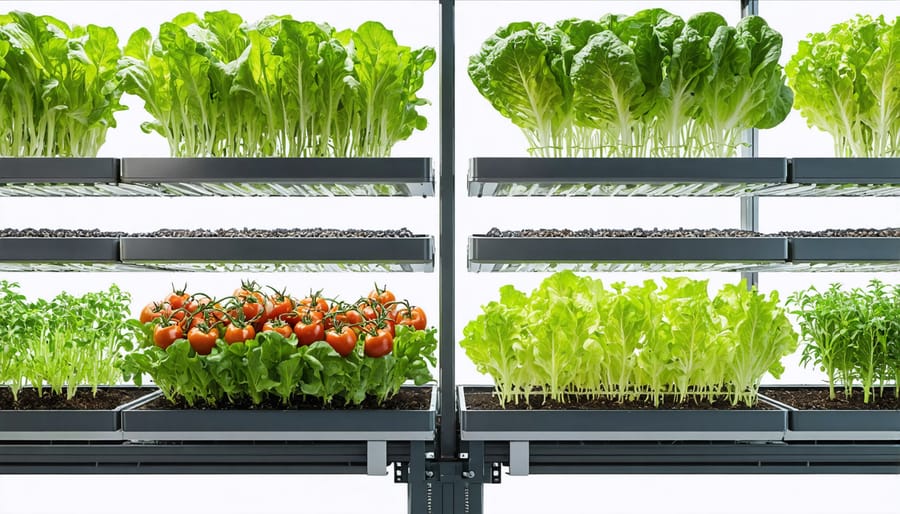
Best Plants for Outdoor Hydroponics
When it comes to outdoor hydroponic gardening, certain plants naturally thrive in these systems, offering excellent yields and adapting well to the unique growing conditions. Let’s explore some of the best options for your outdoor hydroponic garden.
Leafy greens are absolute champions in hydroponic systems. Lettuce varieties, particularly butter lettuce and romaine, grow quickly and can be harvested continuously. Spinach and Swiss chard also perform exceptionally well, providing nutrient-rich leaves with impressive growth rates. Studies have shown that the nutritional value of hydroponic plants can match or even exceed that of soil-grown varieties.
Herbs are another fantastic choice for outdoor hydroponics. Basil, mint, cilantro, and parsley thrive in these systems, offering fresh flavors year-round. These plants are particularly rewarding because they can be harvested regularly while continuing to grow, giving you a constant supply for your kitchen.
Fruiting plants like tomatoes and peppers are excellent candidates for outdoor hydroponics, especially cherry tomatoes and compact pepper varieties. These plants benefit from the controlled nutrient delivery and can produce impressive yields when properly supported. Just remember to choose determinate varieties for tomatoes, as they’re easier to manage in hydroponic systems.
Cucumbers and pole beans are also great options, though they’ll need proper support structures. These climbing plants can maximize vertical space while producing abundant harvests. Consider compact or bush varieties if space is limited.
For beginners, I recommend starting with lettuce and herbs, as they’re more forgiving and provide quick results. As you gain confidence, you can gradually expand to more challenging crops like tomatoes and peppers. Remember that successful growing often depends on choosing varieties specifically bred for hydroponic systems, as these plants are better adapted to water-based cultivation.
Starting an outdoor hydroponic garden is an exciting journey that combines the best of traditional gardening with modern innovation. As we’ve explored, this method offers numerous advantages, from water conservation to higher yields and year-round growing potential. While there may be challenges like weather considerations and initial setup costs, the rewards of growing fresh, healthy produce in your outdoor space make it all worthwhile.
Remember that success comes with careful planning, regular monitoring, and a willingness to learn from experience. Whether you’re starting with a simple DIY system or investing in a more elaborate setup, the key is to begin with the basics and gradually expand your knowledge and garden size.
Don’t be afraid to experiment and adjust your approach as needed. With the right preparation and mindset, you’ll soon be enjoying the fruits (and vegetables!) of your labor while contributing to a more sustainable future. Take that first step today – your outdoor hydroponic adventure awaits!

